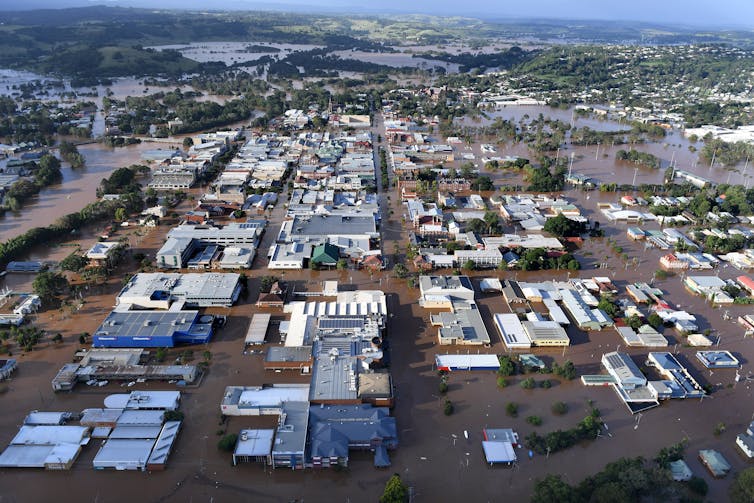This year’s floods in South-East Queensland and Northern New South Wales devastated communities. The NSW flooding was on “a scale never seen before”. More than 5,000 homes were left uninhabitable. Many residents had nowhere else to go.
The NSW government promised to provide temporary housing in the form of 2,000 modular homes. But delivery has been held up by the need for planning approval amid community divisions over some sites.
Flood victims’ continuing struggle to find suitable housing long after the February-March flooding subsided has exposed a critical gap in our plans for recovery from natural disasters. The planning system should be reformed to include temporary housing that provides effective options in the short term (weeks) through to the long term (years). Australia needs to develop a permanent reserve of temporary housing.
In developing this resource, governments must work with communities to avoid the conflicts over temporary housing sites we’re now seeing.
Read more: No, not again! A third straight La Niña is likely – here’s how you and your family can prepare
What are the conflicts about?
In July, Lismore City Council considered a request from Resilience NSW to lease part of Hepburn Park as a site for state-funded temporary housing. The park is used for local sports such as cricket, hockey, soccer, school athletics, touch football and Oztag. The motion lapsed as there was no seconder.
Councillors later did discuss a further NSW government request to use the site for temporary housing. The minister for flood recovery, emergency services and resilience noted there were “no other suitable alternative sites”.
However, there has been a community debate about the importance of retaining sporting grounds for local sports. The council decided this month not to permit temporary housing at the park. This leaves displaced residents with no other options.
Read more: Homeless and looking for help – why people with disability and their carers fare worse after floods
The NSW government promised in April to send up to 2,000 modular homes to communities across the Tweed, Byron, Ballina, Richmond Valley and Lismore areas. Most sites required a lease arrangement with the local council.
By July, only one of 11 sites identified as suitable for housing flood victims had opened at Wollongbar. Others are still being constructed.
The uncertainty about providing shelter for disaster-affected communities six months after the floods confirms the urgent need to co-ordinate policy on temporary housing at all levels of government.
Adding to the existing housing crisis
The disasters of recent years – both floods and bushfires – have added to an ongoing housing crisis in many parts of the country.
After the 2019-2020 bushfires we saw some flexibility in our planning system to permit moveable dwellings without approval. Extended stays in caravan parks or camping grounds for temporary and emergency accommodation were also permitted. This flexibility has been extended so temporary caravan parks or camping grounds can be set up by, or on behalf of, a public authority without planning approval.
The NSW government has committed to providing temporary housing for up to three years after the floods. Yet, as we have seen in Lismore, existing local uses and temporary housing can come into conflict. Unless a long-term solution is found, this conflict will bedevil future disaster responses too.
Our planning system provides little flexibility in achieving this solution. Housing is generally seen as fixed, with temporary housing limited to specific locations such as caravan parks or camping grounds. This approach does not allow for the uncertain and catastrophic impacts of disasters that require immediate responses.
Temporary housing for thousands of people requires extensive infrastructure such as water, sewerage, power and communications. Housing on this scale may have long-term impacts on recreation areas and completely remove their availability for other uses in the short term. Ways to balance ongoing community needs and temporary housing are needed.

Read more: Caravan communities: older, underinsured and overexposed to cyclones, storms and disasters
What planning system changes are needed?
We need to reform our planning system to account for the level of need for temporary housing. We should construct and monitor a minimum number of safe and secure temporary emergency houses each year in at-risk locations across Australia to help meet this ongoing need. At the same time, the needs of communities to access these sites must be considered.
The type and location of emergency and temporary housing needs to be agreed now. This will enable pods and mobile homes to be moved around the country at short notice. People left homeless after a disaster should not be left waiting months for solutions.
In addition, our planning system should provide for different time frames for housing need:
immediate: identify existing buildings across Australia that can be used as multi-purpose evacuation centres – while thousands of flood-stricken people are sheltering in schools, clubs and halls, we can do better
short-term: identify all alternative forms of temporary housing as the people most affected by disasters are often least able to afford short-term accommodation in caravans parks, motels and Airbnbs – which should give first priority to those people with support from government
medium-term: locations should be zoned to allow temporary emergency housing and infrastructure so it can be provided there when needed with no further approvals, with sites managed by community housing providers or partnerships between government and agencies such as the reconstruction authority recommended by the 2022 NSW Flood Inquiry
long-term: the first priority in all planning decisions should be to avoid or minimise exposure to natural hazards – this needs to be enshrined in all planning policies in Australia, as the inquiry recommended.

